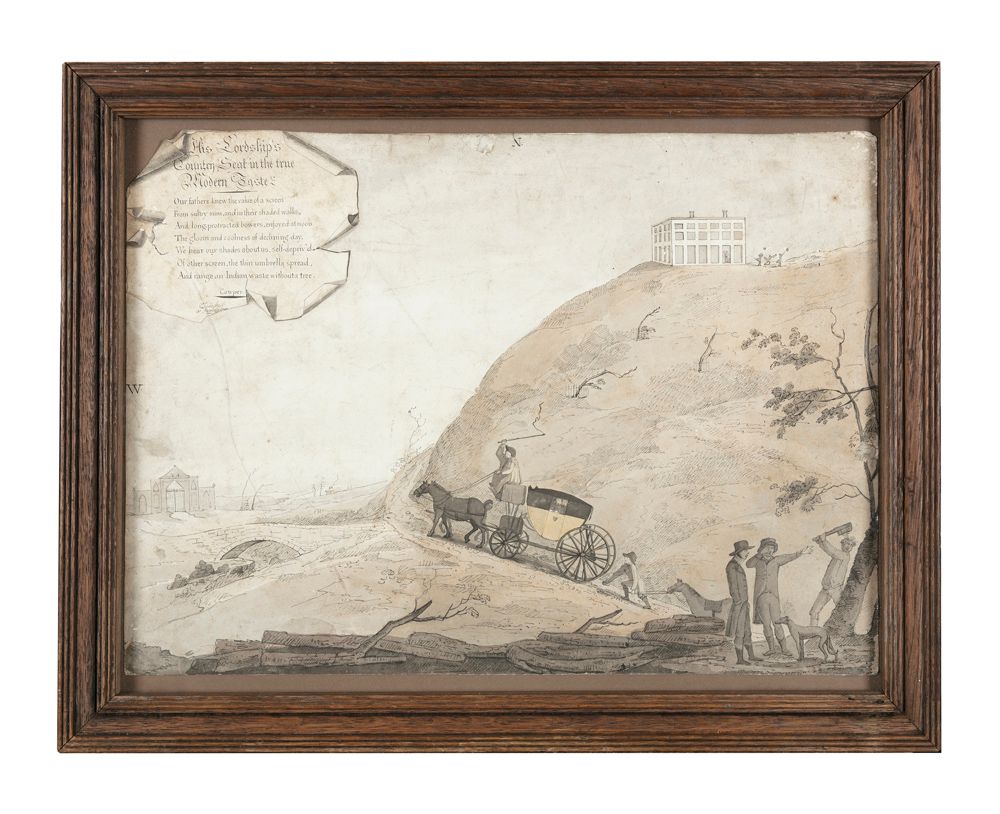Description
CAROLINE HAMILTON (1777-1861) 'His Lordship's Country Seat in the true Modern Taste' A satirical landscape showing a coach and pair struggling up a hill to a 'modern' mansion Signed C. Hamilton decit 31st January 1798 Watercolour and collage, 33 x 43.5cm Nothing escapes Caroline's acute eye. She quotes from the poet Cowper Our father's knew the value of a screen … whilst here the elevated 'post-modern' block of a house receives windswept visitors, park trees struggle to grow, mature trees are cut down, the demesne is entered by a pretenius coronetted gateway whilst beyond is a thatched cottage. Caroline Hamilton was the daughter of William Tighe of Rosanna and Sarah Fownes of Woodstock. She married Charles Hamilton of Hamwood in 1801. Brought up in a family that stressed education for daughters that included Continental tours and the appointment of John Spilsbury the Harrow School Art Master as tutor. She later made a protégée of this man's niece, Maria Spilsbury Taylor. Influenced by the family's support for the Christian evangelist, John Wesley, her social conscience found expression through the medium of her training in drawing and watercolours, and she became a true satirist. Her cutting depictions of Dublin society castrated by the Act of the Union are known. She was also the main beneficiary of the will of her cousin, Sarah Ponsonby, the surviving partner of Lady Betty Butler, the Ladies of Llangollen.
477
CAROLINE HAMILTON (1777-1861) 'His Lordship's Country Seat in the true Modern Taste' A satirical landscape showing a coach and pair struggling up a hill to a 'modern' mansion Signed C. Hamilton decit 31st January 1798 Watercolour and collage, 33 x 43.5cm Nothing escapes Caroline's acute eye. She quotes from the poet Cowper Our father's knew the value of a screen … whilst here the elevated 'post-modern' block of a house receives windswept visitors, park trees struggle to grow, mature trees are cut down, the demesne is entered by a pretenius coronetted gateway whilst beyond is a thatched cottage. Caroline Hamilton was the daughter of William Tighe of Rosanna and Sarah Fownes of Woodstock. She married Charles Hamilton of Hamwood in 1801. Brought up in a family that stressed education for daughters that included Continental tours and the appointment of John Spilsbury the Harrow School Art Master as tutor. She later made a protégée of this man's niece, Maria Spilsbury Taylor. Influenced by the family's support for the Christian evangelist, John Wesley, her social conscience found expression through the medium of her training in drawing and watercolours, and she became a true satirist. Her cutting depictions of Dublin society castrated by the Act of the Union are known. She was also the main beneficiary of the will of her cousin, Sarah Ponsonby, the surviving partner of Lady Betty Butler, the Ladies of Llangollen.
You may also like
